Trekking in the remote Kingdom of Mustang: Upper Mustang trek
Once you have trekked in Upper Mustang it is easy to see why it is hailed as ‘The last forbidden Kingdom’. The scenery along the entire route is simply stunning and the high cost of the permit ensures that very few trekkers visit the region, meaning that for much of the time you have the place to yourself. The trek was tougher than I expected and you cross no less than eight passes en route to and from Lo-Manthang, the region’s ancient, walled capital. You also have to battle with the elements; the wind and the dust can be relentless. This is especially true when walking south as you are heading into the wind and furthermore, the trails are not as well defined as on other trekking routes. However, ultimately this all adds to the adventure and a trek in Upper Mustang is a once in a lifetime opportunity.
Trekking in Upper Mustang is not cheap. The permit for the region cost US$500 for 10 days (and US$50 per person per day thereafter) plus, as a minimum requirement, it is compulsory to hire the services of a Sherpa/guide, which is an additional cost. But the good news is that the common misconception that you need to arrange a full support trek (*) in order to visit Upper Mustang is, in fact, not correct. There are teahouses along the route and using them instead of camping will keep the overall cost of your trek to a minimum.
Most of the teahouses only have three or four rooms, but this shouldn’t be too much of an issue as the region sees very few visitors.
(*) A full support trek is normally based on staying in tents and includes a much larger crew of porters (to carry all the camping equipment) as well as a cook and the compulsory Sherpa/guide. This style of trek is great for groups of 8+ but works out to be quite a bit more expensive for any group size smaller than that. Based on current regulations, the minimum group size for trekking in Upper Mustang is two people, i.e. no solo trekkers.
Upper Mustang trek summary
Day 1 Pokhara to Jomsom and onto Kagbeni (20 minute flight and 3 hours walking/10km)
Day 2 Kagbeni to Chele (5hrs walking)
Day 3 Chele to Syangboche (6/7hrs walking)
Day 4 Syangboche to Charang (Tsarang) (6/7hrs walking)
Day 5 Charang to Lo-Manthang (4hrs walking)
Day 6 Rest day in Lo-Manthang
Day 7 Lo-Manthang to Ghemi (7hrs walking)
Day 8 Ghemi to Samar (6hrs walking)
Day 9 Samar to Kagbeni (6/7hrs walking)
Day 10 Kagbeni to Jomsom (2.5hrs walking)
Day 11 Jomsom to Pokhara (20min flight)
Upper Mustang Trek trekking route
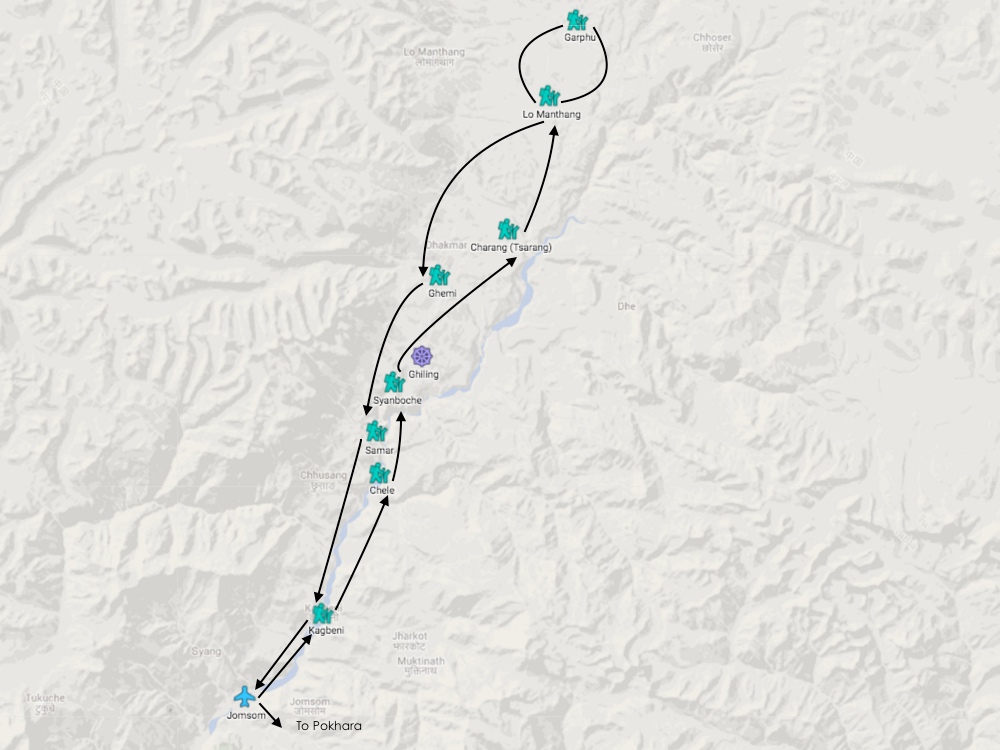 Click on the map for a Google map interactive version
Click on the map for a Google map interactive version
Upper Mustang Trek in detail
Day 1 Pokhara to Jomsom and onto Kagbeni (3hrs)
As the flight from Pokhara to Jomsom cannot be guaranteed to take off (the schedule is dependent on the weather), the first night on this particular trek should always be spent in Kagbeni. The trekking permit for Upper Mustang is date specific. You can enter on or after the date specified on your permit but not before. Kagbeni itself is an entrancing, medieval-style village so it won’t be time wasted. Plus sleeping in Kagbeni (2800m) on the first night allows for some acclimatisation time before heading higher once you start the trek.
It is possible to drive from Pokhara to Jomsom and sometimes even as far as Kagbeni. Bank on at least seven hours to get as far as Jomsom, and depending on the state of the road at the time, be prepared for a bumpy ride for at least 50% of the journey.
Accommodation in Kagbeni
Lodges/teahouses
There are at least three decent teahouses to choose from in Kagbeni. I stayed at the excellent Mustang Gateway Hotel where rooms are spacious and clean and have private bathrooms. Other good lodges include the Asian Trekkers Home which is located close to the village entrance, the Shangri La Hotel and the New Annapurna Lodge. The interestingly named Yac Donalds restaurant serves very good organic food.
Camping
There are three campsites within the village. The best is opposite the Mustang Gateway Hotel.
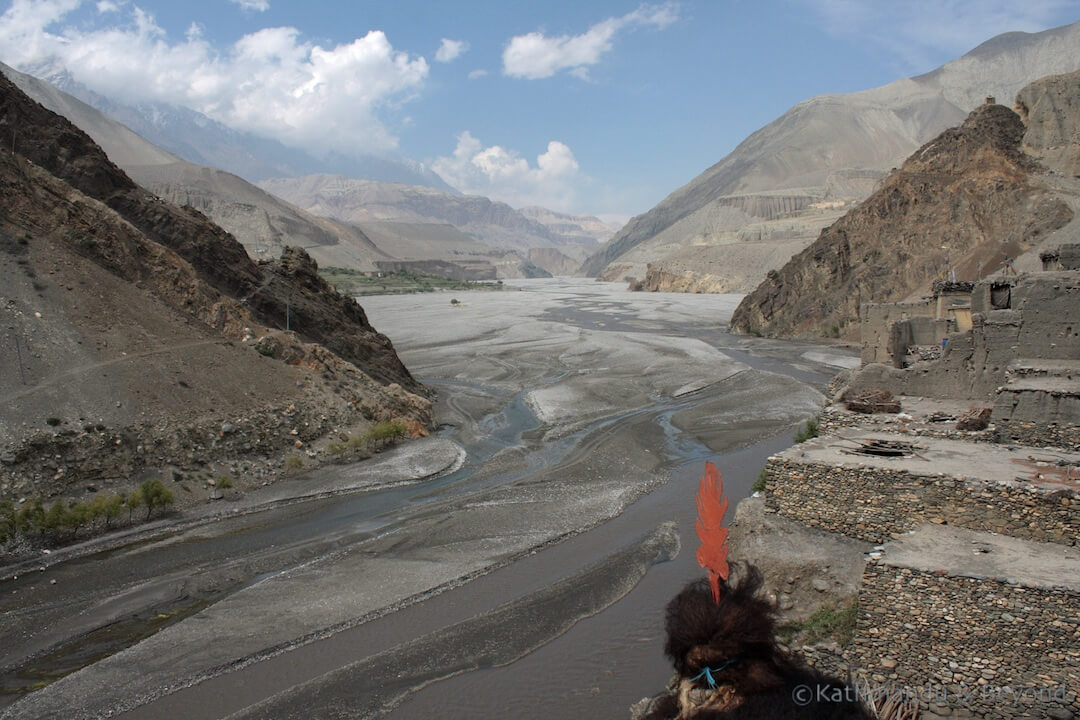 En route between Kagbeni and Chele
En route between Kagbeni and Chele
Day 2 Kagbeni to Chele (6hrs)
Today starts with a short walk through the village to the official checkpoint, where it takes about 30 minutes to complete formalities. Thereafter you are allowed to enter Upper Mustang and it’s quite uncanny, but literally crossing the border takes you into another world; the scenery instantly changes and the Kali Gandaki Gorge opens up before you. If the riverbed is navigable (i.e. dry) then it is possible to walk straight along it for the first 30 minutes or so and avoid the long haul up and over the ridge to the east. If not, the first hour of the trek will be spent tackling this ridge. After passing the small village of Tiri Gaon to your west, it is necessary to pick up the high path anyway and follow it all the way to Tangbe. This is the first major settlement along the route. From here the path climbs and hugs the mountainside until finally reaching Chhusang, which is a good place to stop for lunch. This whole section takes around 4 to 4.5 hours. From Chhusang it’s a straightforward walk of around an hour along the riverbed (or the high route, depending on the season) to the foot of Chele. This is followed by a tough 20 minute climb to the village itself.
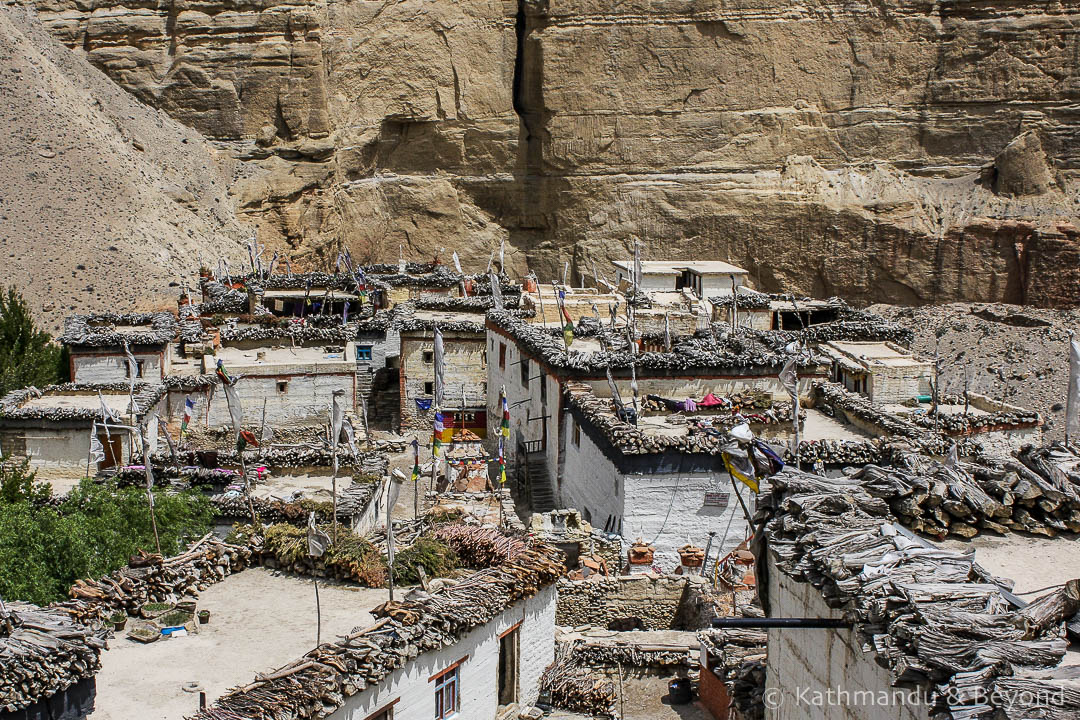 Chele
Chele
Accommodation in Chele
Lodges/teahouses
At the time of my trek, there were only two teahouses in this very tiny village, the Deuralee/Mena Guesthouse and the Bisha Guesthouse. Both are basic and only have a handful of rooms but are acceptable for an overnight stop.
Camping
There are three campsites in Chele, one in the courtyard of the Bisha Guesthouse, one just below it and another just above it. Out of the three, the one just below the Bisha Guesthouse is the best, in my opinion.
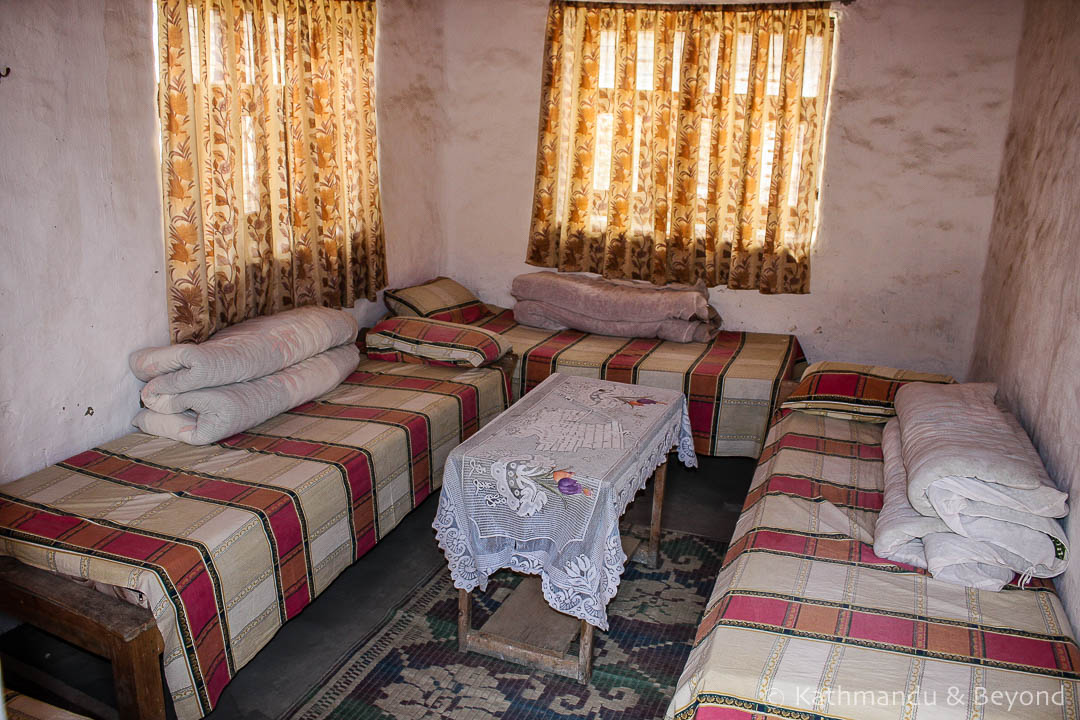 Bisha Guesthouse, Chele
Bisha Guesthouse, Chele
Day 3 Chele to Syangboche (6/7hrs)
Soon after leaving Chele you start to climb and this continues for at least a couple of hours. It is a tough walk to the morning’s first destination, the village of Samar, along what is known as the ‘Canyon Cliff Road’. This is a fair description as the path is very narrow in places and there are some sheer drops thrown in for good measure. You also cross two passes between Chele and Samar, the Taklam La (3624m) and the Dajori La (3736m) and all things considered, this is a hard few hours of trekking.
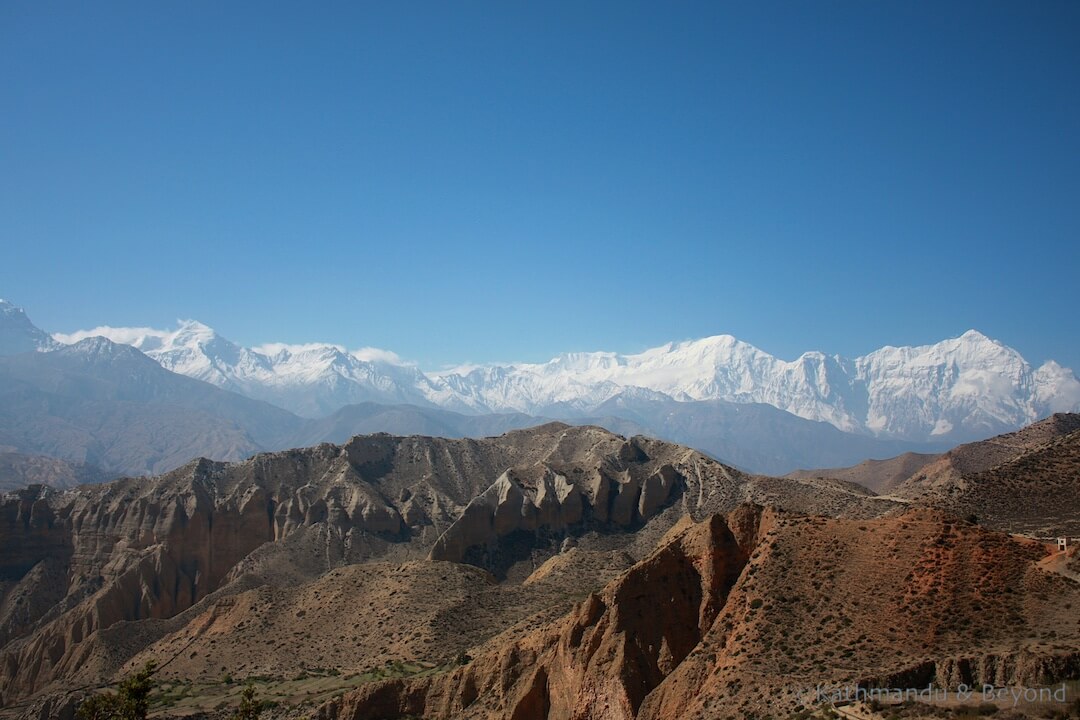 En route between Samar and Syangboche
En route between Samar and Syangboche
Samar is a good place to have lunch (at the Annapurna Guesthouse) and then, after leaving the village, it is necessary to head all the way down to the river and then all the way back up again in order to continue on the trail. This section takes at least an hour and when you look back to where you started you will notice that as the crow flies, you have covered hardly any distance whatsoever. The walking only gets tougher and it’s a hard slog up for almost all of the rest of the day. To compensate, the views in this section of the trail are outstanding.
Accommodation in Syangboche
Lodges/teahouses
Syangboche is a tiny place but it still has three teahouses. The best one is the Dhaulagiri Guesthouse which has 5 rooms and a nice bright dining room.
Camping
There are also three campsites, attached to each of the teahouses. All are OK but my first choice would be the one belonging to the Dhaulagiri Guesthouse.
Note it is also possible to overnight in Geling which is an hour further along the trail but the teahouses and camping are not as good there and also the villagers will not allow horses to graze (*).
(*) Locally hired horses or mules are often used to carry trekking equipment on a full support trek in Upper Mustang.
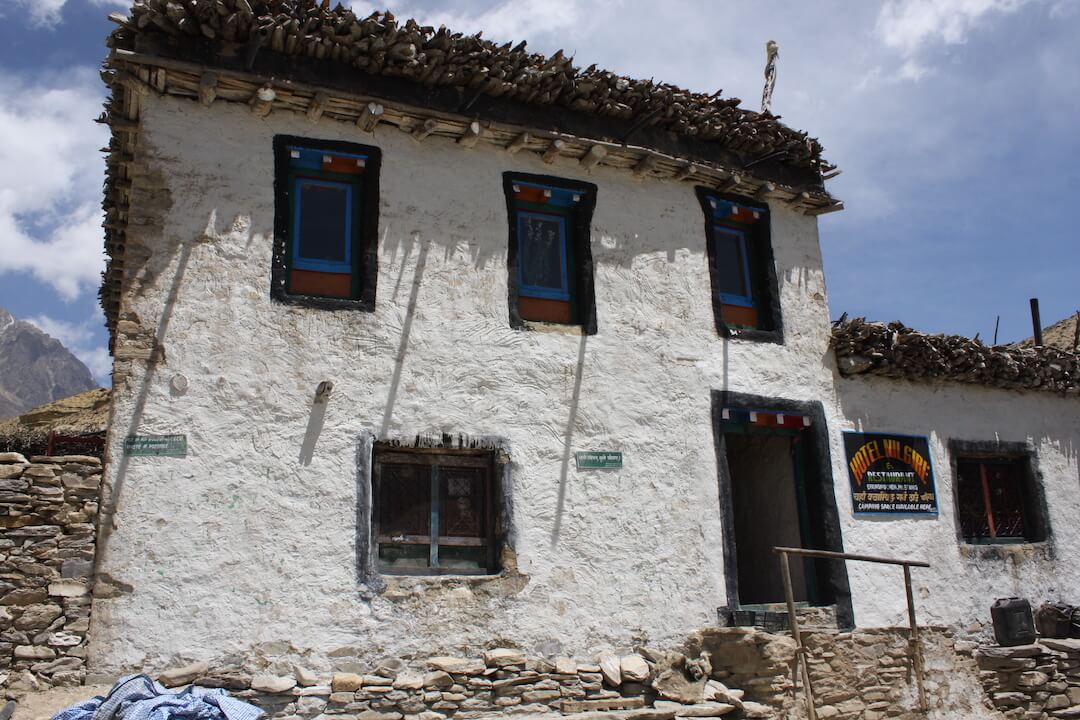
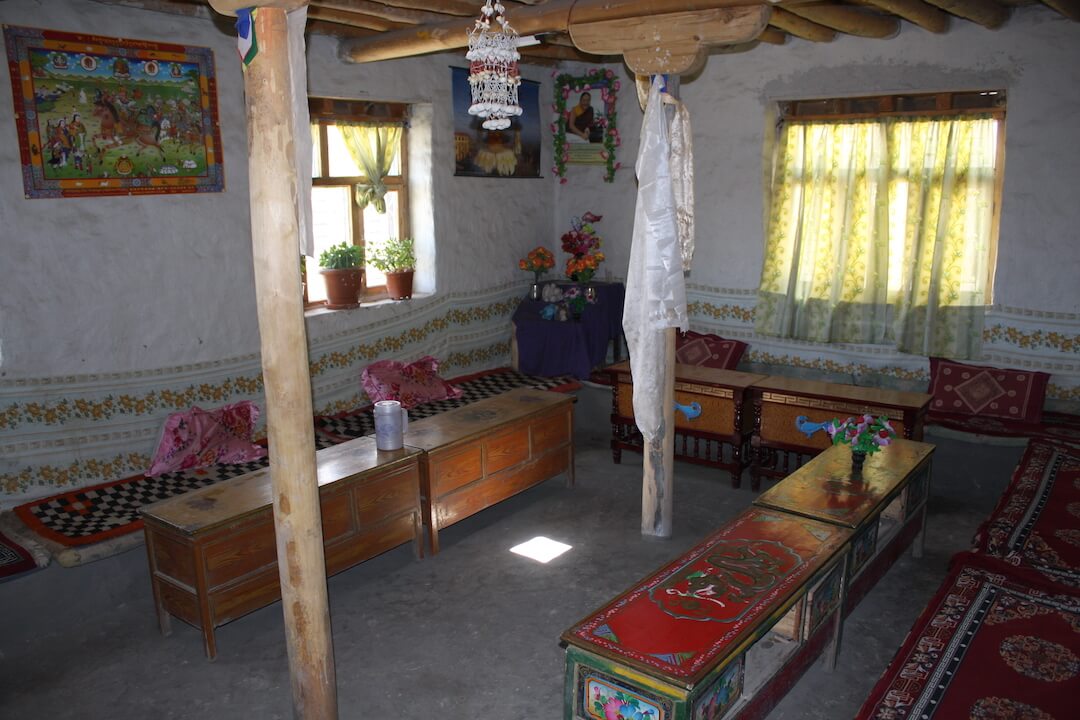
Syangboche: Hotel Nilguri (left) and Daulaguri, Guesthouse (right)
Day 4 Syangboche to Charang (Tsarang) (6/7hrs)
It’s a gentle climb from the village to the Syangboche La (La means pass)(3870m). This is followed by a bit of down (bypassing Geling) and then some more up as you pass Tama Gaon and eventually reach Jaite (*). After leaving Jaite it is a fair old climb up to the Nyi La (4020m) and a gradual descent down the other side until you arrive at Ghemi.
(*) Up, followed by down and then some more up is known as Nepali flat. It’s very tedious at times and often you make very little gain in elevation. Take the Jiri to Lukla trek as an extreme example. It takes 5 to 7 days to walk between the two places and most of the route involves long upward hauls, followed by knee-jarring walks down; and when you finally reach Lukla you haven’t even gained 1000 metres in height!
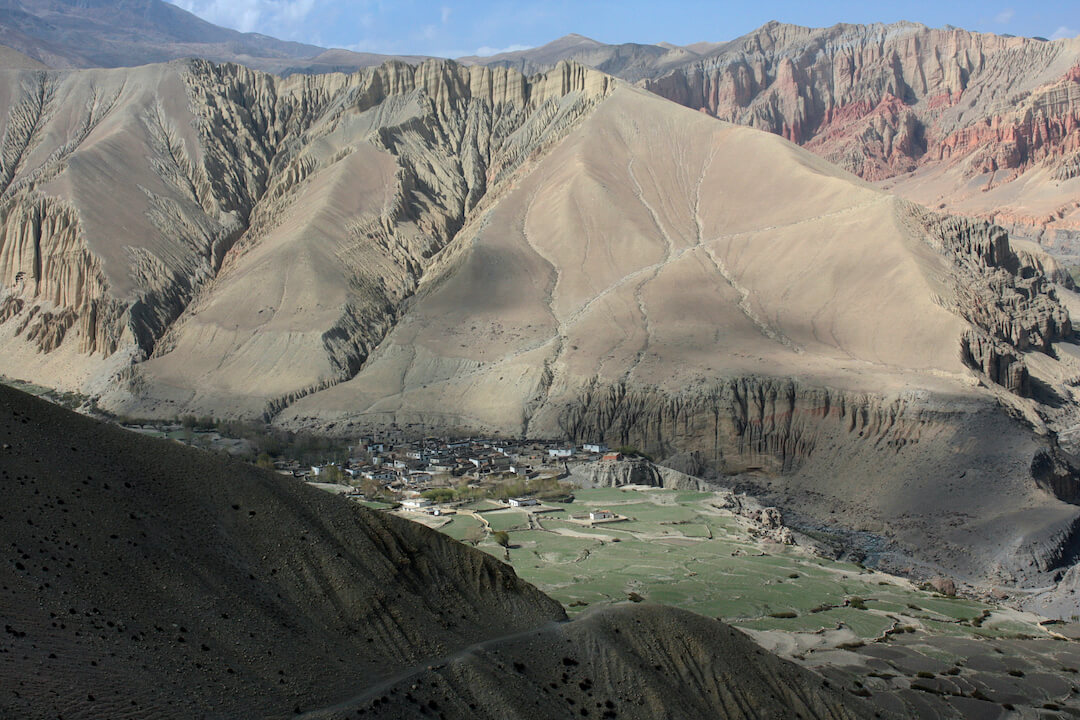 En route between Syangboche and Ghemi
En route between Syangboche and Ghemi
After leaving the pass the scenery changes quite dramatically and the stunning ‘flaming’ mountains which are often associated with Upper Mustang finally come into view. Ghemi itself is an interesting village and worth exploring as well as being a good place to stop for lunch.
After Ghemi, the route turns into a series of switchbacks, which you will need to ascend for at least 1.5 hours until you reach the Tsarang La (3870m). Once at the top of the pass, it is a gentle descent down through yet more splendid scenery, followed by 1.5 hours on the flat until you reach the village of Charang. This is an enjoyable afternoon of walking and Charang itself has an impressive monastery and former Royal Palace, which you can visit later in the day if your energy levels allow.
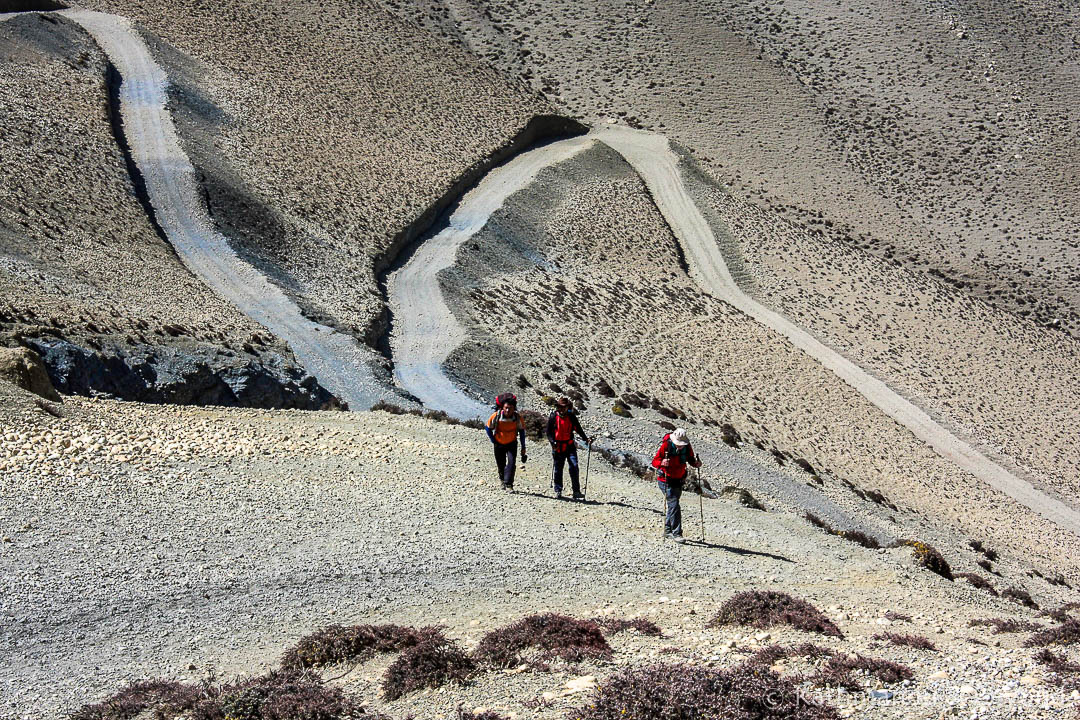 En route between Ghemi and Charang
En route between Ghemi and Charang
Accommodation in Charang
Lodges/teahouses
There are three teahouses in Charang; Kailash, Maya and Damodar. All have two or three rooms and of the three, the best is the Kailash Guesthouse.
Camping
All three of the above mentioned teahouses have an attached campsite. The one at the Kailash is pretty small but the best available. The one at the Maya is right next door to the horse stables and so best avoided.
Day 5 Charang to Lo-Manthang (4hrs)
This is a short day to allow for an afternoon of exploration in Lo-Manthang (*). After leaving Charang, it is necessary to head down to the river and then trek straight back up again. This section takes about 45 minutes to complete and, as the crow flies, you only cover about half a kilometre. It’s yet another classical example of Nepali flat!
(*) Mustang was formerly known as the Kingdom of Lo.
You have now entered the Tholung Valley and it’s a slow slog up to the Lo La (3950m), from where you will get your first view of Lo-Manthang. There is then a tricky descent along a heavily sanded path that takes you right to the entrance of the capital. The scenery along this stretch is extremely scenic and the rest of the afternoon can be spent exploring the town. There are four major temples in Lo-Manthang and each one charges an entry fee of NPR100 (about US$1). The temples were interesting enough but for me, the highlights were people-watching and wandering through the backstreets.
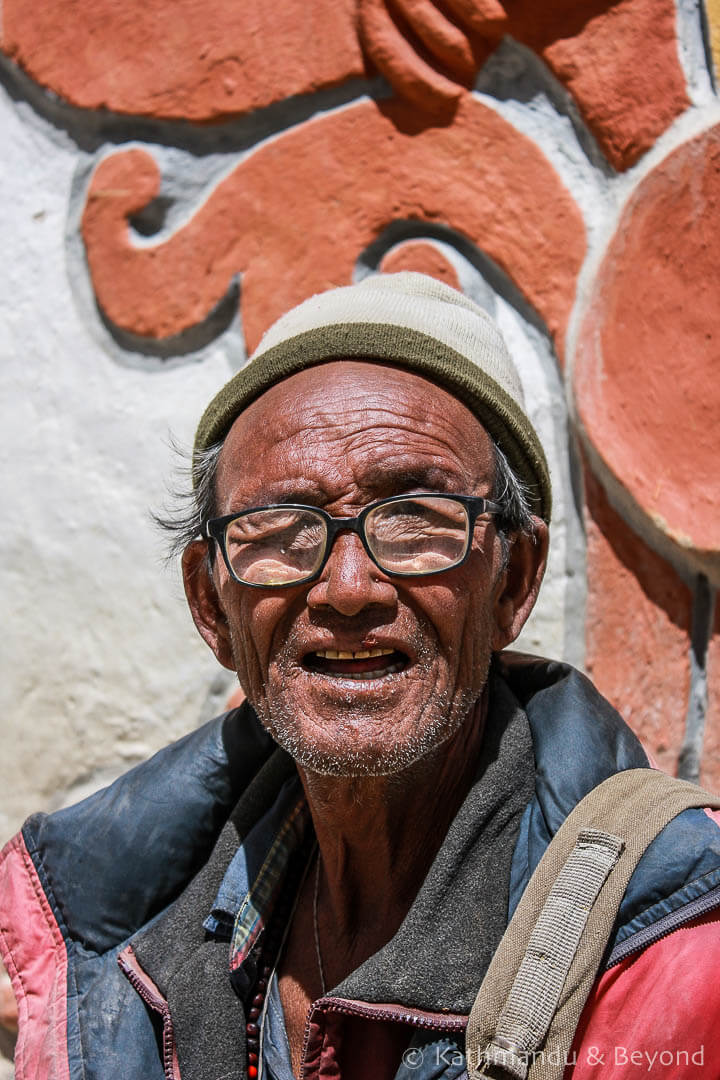
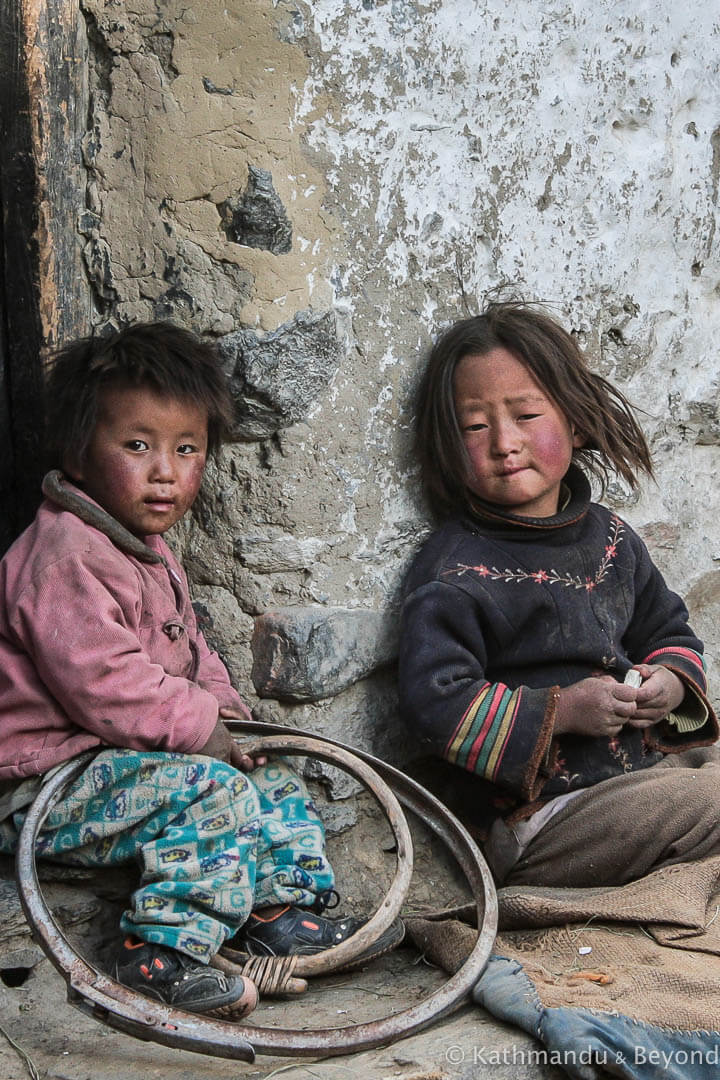
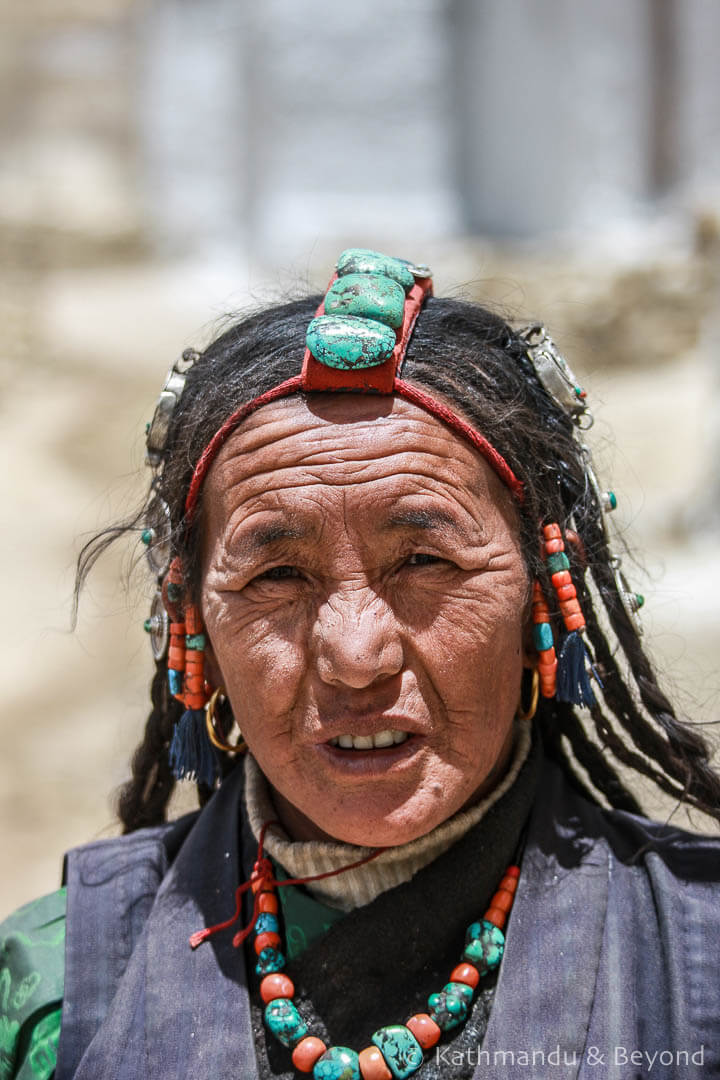
People of Upper Mustang: Charang (left), Ghemi (centre) and Garphu (right)
Accommodation in Lo-Manthang
Lodges/teahouses
The Lomanthang Guesthouse is the best location to make a beeline for. It’s a friendly place and is situated on the main square opposite the palace. The property has an old and new part. The rooms in the old part are basic whereas those in the new wing are much nicer. Some of the rooms in the new wing have an attached bathroom, although running water can be an issue (*). There is also a dining area in the new wing but unless you’re in a big group, it is nicer to go across to the kitchen/dining room in the original part of the building and have your meals there.
(*) Note that generally, running water can be an issue in Lo-Manthang and is often in limited supply. There is also the Mystique Himalayan Resort, which has eight rooms (some with attached bathroom and some with common bathroom) but it is not as good as the Lomanthang Guesthouse.
Camping
There are several reasonable campsites dotted throughout the town, all similar so a
recommendation is not really necessary.
Day 6 Lo-Manthang (rest day)
There is a 4 to 5 hour excursion north of Lo-Manthang to the village of Garphu, which has an interesting gompa (monastery) in a picturesque setting. It is a fairly easy hike that gets you within 20km of the border with Tibet and also provides some fantastic views of the mountains.
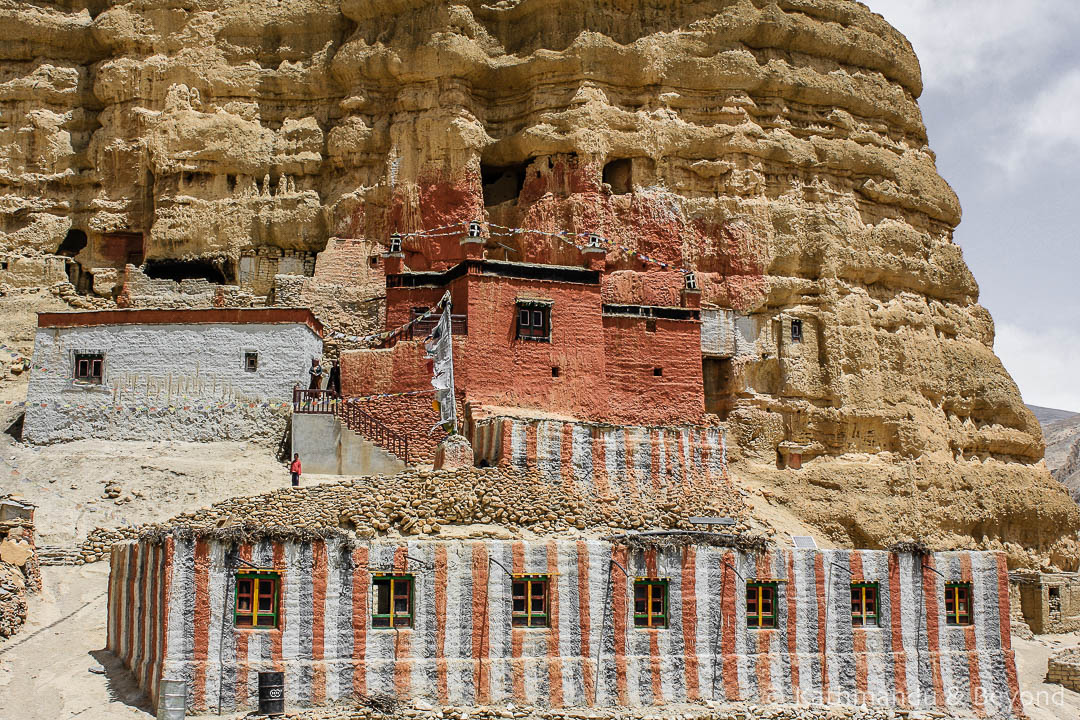 Garphu
Garphu
If you are feeling energetic and happy to carry a packed lunch, the day can be extended to include a visit to Tingkhar, which is the site of the raja’s summer palace, and also Namgyal gompa. This makes for a tougher day of trekking but means you can make a circuit out of Lo-Manthang as opposed to a straight there-and-back excursion.
Day 7 Lo-Manthang to Ghemi (7hrs)
There is an opportunity to vary the return journey at least as far as Ghemi by returning south via Drakmar rather than Charang. This is a tough journey that involves crossing the Chogo La which, at 4320m, is the highest point on the trek.
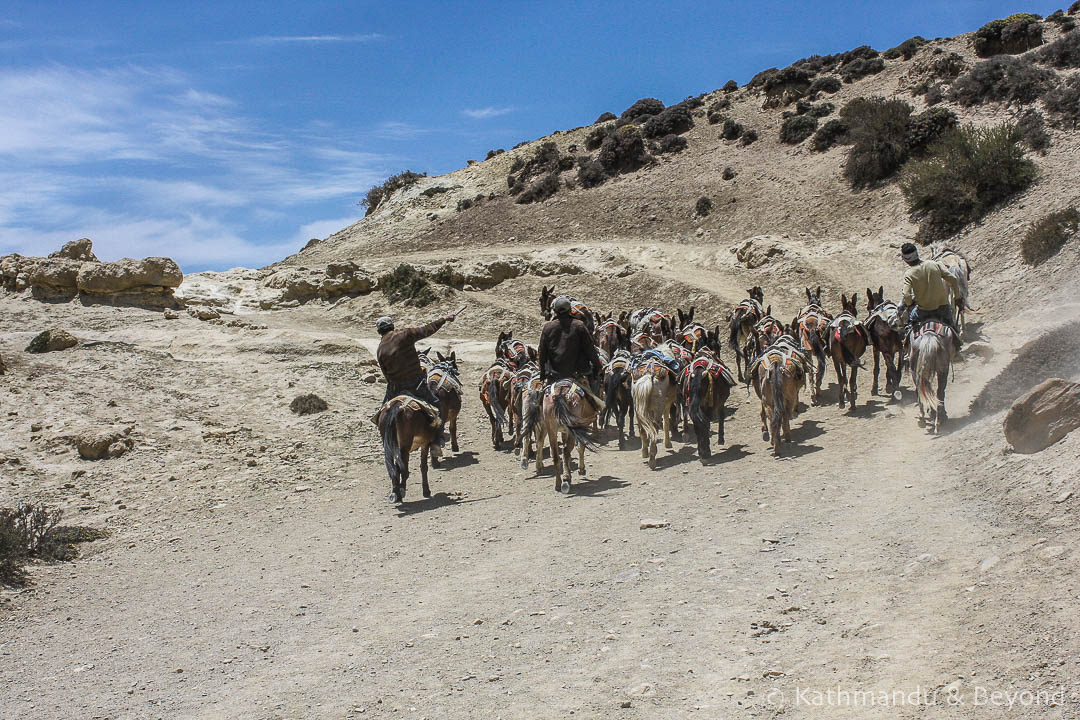 En route between Syangboche and Ghemi
En route between Syangboche and Ghemi
Be prepared to start early to avoid the wind as much as possible (*) and carry a packed lunch. The most suitable (and interesting) place to stop for a rest is Lo Gekar, which is home to Ghar gompa. There are lots of ups and downs on this part of the trail but your reward is some incredible scenery for the entire route. There are great vistas of both Marang and Charang villages as well as a birds-eye view of the flaming red cliffs at Drakmar. After passing Drakmar, it’s a final one hour slog directly into the wind in order to get to Ghemi, where you will arrive exhausted!
(*) You will definitely need either a bandana or some other form of face mask like a ski mask plus a pair of wraparound sunglasses to protect your face and eyes. The wind is relentless and carries a lots of sand grits.
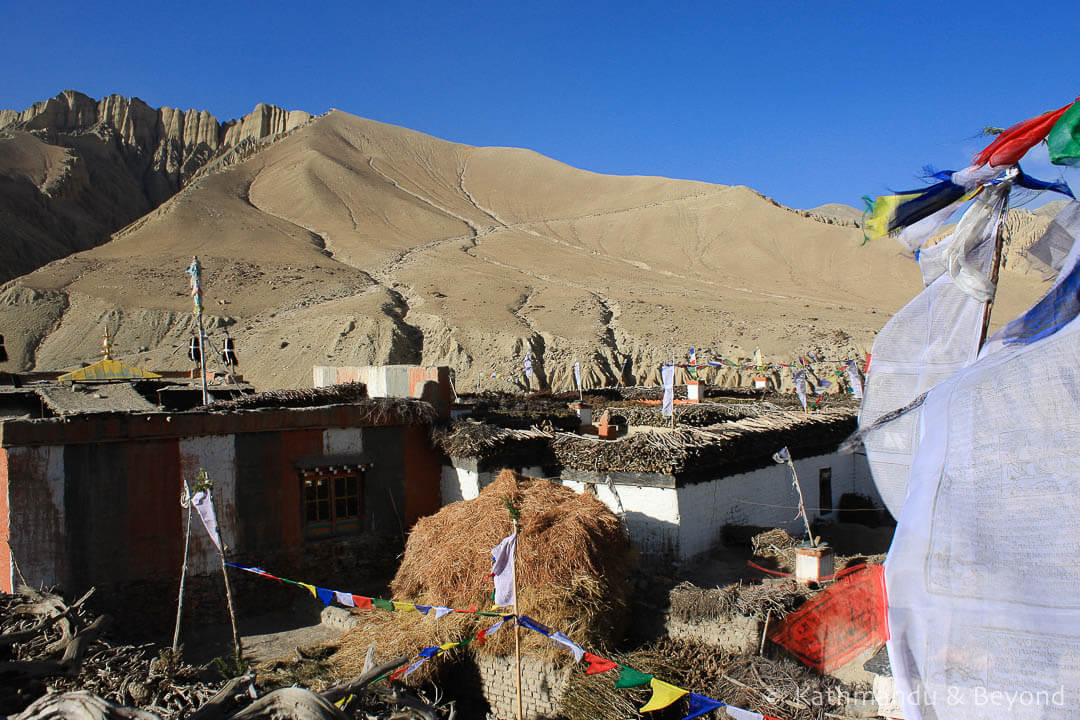 Ghemi
Ghemi
Accommodation in Ghemi
Lodges/teahouses
There are two teahouses in Ghemi; the Royal Mustang Guesthouse and Lo Ghemi Guesthouse. Of the two, I preferred the Royal Mustang Guesthouse.
Camping
There are three campsites in Ghemi. The Royal Mustang has two sites, one opposite the lodge and another a couple of minutes away. The other belongs to the Lo Ghemi Guesthouse. The one opposite the Royal Mustang is the nicest one.
Day 8 Ghemi to Samar (6hrs)
There are two options for the return journey to Syangboche. The direct route involves a 20 minute walk on the flat followed by a steep descent and a reasonably tough ascent to Syangboche La (3850m). This section then ends with a 10 minute steep down to the village itself.
An alternative and longer route will have you retracing your steps as you climb up and out of Ghemi village and over the Ghemi La and the Nyi La to Jaite. From here, it is possible to make a detour and visit the gompa at Geling. This adds about 1.5 hrs to the overall journey time and involves a hard climb up to Syangboche. It’s debatable as to whether the side trip is worth the effort but the option is there if you have the energy and inclination. Either way, it’s a good idea to stop in Syangboche for a rest and possibly lunch as the next section of the trek as far as Samar is a series of ups and downs and takes approximately 3 hours to complete. On the final leg, you can clearly see Samar in the distance, and if you were able to walk directly to the village it would take around 15 minutes but of course to get there, you first need to go down, then up and then down again and then up again and the whole section takes at least 50 minutes! Brush up on your oaths and curses!
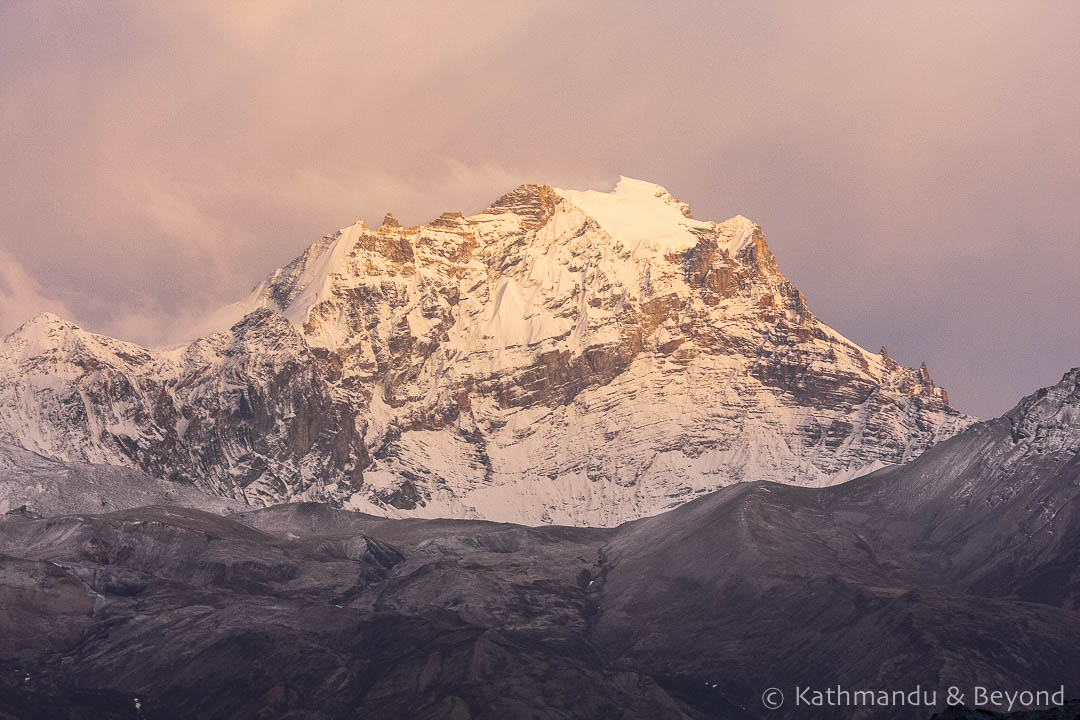 Mountain views from Samar
Mountain views from Samar
Accommodation in Samar
Lodges/teahouses
There are two teahouses in Samar. The Annapurna guesthouse is by far the nicest and has four or five clean rooms plus an excellent hot shower and airy dining room (although it is also possible to eat in the kitchen). The other teahouse is called the Himalaya Guesthouse.
Camping
The Annapurna guesthouse has a very pleasant campsite behind the property which has its own separate cooking and dining area. The Himalaya also has a small campsite.
Day 9 Samar to Kagbeni (6/7hrs)
This is a very hard day. It doesn’t actually start too badly (a gentle descent back down to the village of Chele that takes around 2 hours) but thereafter the trek becomes a real challenge because you once again enter the river bed of the Kali Gandaki Gorge but this time, however, you are walking south and you have the wind against you for the entire day. Start early would be my advice as the wind picks up as the day progresses and the walking becomes a real struggle. This is further compounded by the fact that you keep having to come off the river bed and climbing onto the high trail and then back down again, which also contributes to diminishing your energy supply. An hour after leaving the village of Chhusang, you find yourself completely exposed to the elements and by the time you reach Kagbeni you are totally drained.
Day 10 Kagbeni to Jomson (2.5hrs)
Compared to the previous day, this section of the trek is a walk in the park. You are still trekking through the Kali Gandaki Gorge but in the morning there is hardly any/no wind and for the best part, you walk slightly above the river bed floor on a well-defined track. The afternoon is free to relax and explore Jomson, which is practically a metropolis when compared with places you have just visited in Upper Mustang.
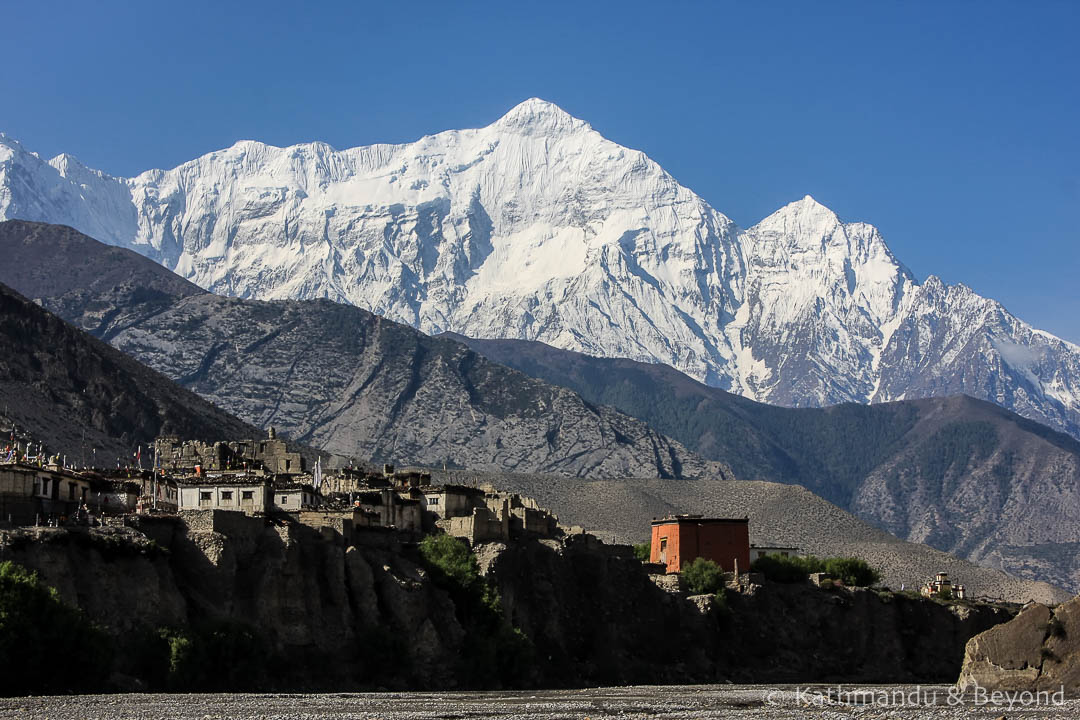 Kagbeni
Kagbeni
Day 10 Kagbeni to Jomsom (2.5hrs)
Compared to the previous day, this section of the trek is a walk in the park. You are still trekking through the Kali Gandaki Gorge but in the morning there is hardly any/no wind and for the best part, you walk slightly above the river bed floor on a well-defined track. The afternoon is free to relax and explore Jomsom, which is practically a metropolis when compared with places you have just visited in Upper Mustang.
Accommodation in Jomsom
Lodges/teahouses
Jomsom is divided into the old and new part. Nearly all the teahouses are in the new part of town and close to the airport. The exception to this is the Jomsom Mountain Resort which is perched on a hill overlooking the town and is by far the best property in Jomsom. With luxuries such as bathrobes, satellite television and an indoor swimming pool(!!), the Jomsom Mountain Resort is definitely a cut above anything else in Jomsom, but the steep climb up from the town is very off-putting after ten days of trekking in Upper Mustang. Alternatives in Jomsom itself include the Om guesthouse and the Hotel Alaka Marco Polo. Both have clean rooms, attached bathrooms and hot showers.
Camping
There is only one campsite in Jomsom at the Hotel Alaka Marco Polo but it is pretty terrible and my suggestion would be to forget camping for one night and treat yourself to a comfortable bed in one of the town’s numerous lodges or teahouses.
Day 11 Jomsom to Pokhara (2.5hrs)
There are a few options for getting back to Pokhara. Firstly, there is the flight but remember the schedule is dependent on the weather so you will need to be flexible with your onward plans. Alternatively, it is possible to drive from Jomsom to Pokhara either by jeep/4WD or bus. Both modes of transport take at least 9 hours to complete the journey plus the road is very rough in parts and prone to landslides. Again, you will need to be flexible with your onward journey. The final option (and the best in my opinion as long as you have the time and energy) is to trek back down. ACAP (Annapurna Conservation Area Project) have created alternative trails that keep you away from the main road.
Opinion on the Upper Mustang trek
This is one of those treks that you enjoy retrospectively, in my opinion. The relentless wind, constant dust and Nepali flat all contribute to making Upper Mustang a tough little trek indeed. There are numerous occasions when you wonder why on earth you are battling with the elements in order to get to Lo-Manthang, only to then turn around and come back again a day or so later. But then you remember that this is Upper Mustang and how many people/trekkers do you actually know that have been to Upper Mustang – probably the answer is none and that’s a good enough reason alone to visit!
The scenery is incredible and I was pleasantly surprised by the accommodation and food options available along the route but on the flip-side, I was disappointed with the people themselves. The Lopa (I think is the right name for people from the region) seemed less friendly and more money grabbing than locals in other parts of the Annapurna region. I think part of the problem is the fact that, because of the high cost of the permit, etc., often it is only rich tourists (some are not even trekkers) who visit Upper Mustang and the Lopa who come into contact with these type of visitors have got used to them flashing their cash. For example, kids constantly ask for pens, money etc. and you cannot take a photograph of anyone without them expecting several rupees in return. But, all things considered, Upper Mustang is incredibly beautiful and I certainly consider it to be one of the best treks I have ever done.
Disclaimer. This trek was undertaken a few years back and hence information about the splendour or otherwise of teahouses and camping sites may be slightly out of date. The Upper Mustang region suffered some damage during the devastating earthquake of April 2015 but the trekking routes were largely unaffected. I have checked with travel-industry colleagues in Nepal and incorporated their updates but if you come across new information please feel free to update me. All such contributions will be duly acknowledged. Mark

This is very interesting and well done, with great photos. I was in Kagbeni in 1994 and went up to the gate to Mustang, but without a permit that was as far as I got. Now I have a much clearer idea of what I missed.
If you ever make it, spend longer than a day or two in Lo Manthang, I didn’t but wish I had. It’s a hard trek and having arrived, you begin to focus on heading back but it’s worth hanging around another day as you won’t find anywhere like it in Nepal!
This a very useful and interesting blog of the Upper Mustang Trek with good information on trekking conditions, trekking times and tea houses. I want to do it in 2018 with my wife and up to now it has been difficult to obtain information on the tea houses as my wife doesn’t like to slum it too much. She coped with the tea houses on the Everest Base camp trek but they are bigger than the ones mentioned in your blog.
I have just bought A Trekking Guide to Upper and Lower Mustang by Sian Pritchard-Jones and it is excellent on the various route options. From what they say I will probably get a trekking permit for 14 days so I can spend 3 or 4 nights in Lo Mathang, like you and the book recommend, plus go to places like Yara/Luri and Konchok Ling and not rush things. I would like to hike back along the very scenic East bank to but unfortunately the 11 hour stretch from Tangge to Tetang would be too much for my wife. Thanks for all your efforts in providing this information.
Hi Peter, thank you for the feedback and I’m glad you found the post useful. As you point out, the teahouses along the route to Everest Base Camp are superior to those in Upper Mustang but at least they exist now, previously the trek could only be completed using tents and camping equipment, which necessitated a larger crew of porters etc. Definitely spend as long as you can in Lo Mathang. As well as being the most interesting village on the trek, it is also a good base for day walks to other places in the region. Enjoy the trek!!
Thanks for this post Mark. Quick question, based on your experience on these trails would you recommend boots or would a decent pair of hiking shoes suffice.
Hi Julian, personally I always wear boots that go above the ankle but my Nepalese trekking partner never did and he got on fine! The trails in Upper Mustang aren’t tricky and I think decent hiking shoes would be fine but it depends on how you are going to get there. If you are walking up via the Thorong La for example then I would suggest good boots as the trails on that route are more demanding. The only other thing that comes to mind is the fact that you need to walk along the river bed after leaving Kagbeni for some time and that can be tricky underfoot and has potential for rolling an ankle.